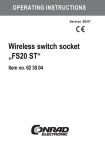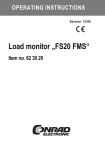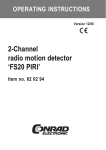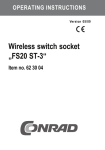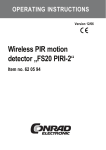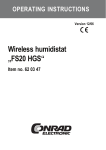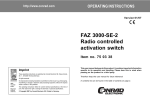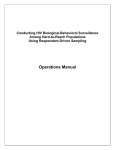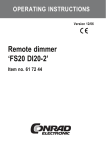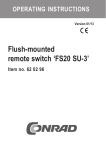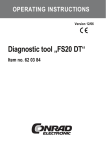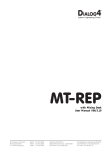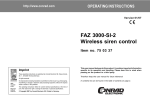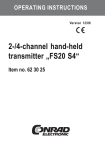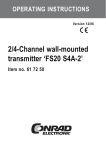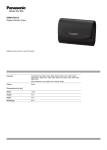Download Wireless thermostat set „FS20 STR“
Transcript
OPERATING INSTRUCTIONS Version 12/06 Wireless thermostat set „FS20 STR“ Set consists of: 1 x ‘FS20 STR’ wireless thermostat 1 x ‘FS20 ST-2’ wireless switch socket Item no. 62 04 23 Introduction Dear customer, Thank you for purchasing this product. This product meets the requirements of both current European and national guidelines. In order to preserve this condition and ensure the safe operation of the product we kindly ask you to carefully follow these operating instructions! Please read the operating instructions completely and observe the safety and operation notes before using the product! All company names and product names contained herein are trademarks of the respective owners. All rights reserved. Should you have any further questions, please contact our technical advisory service: Germany: Tel. no.: +49 9604 / 40 88 80 Fax. no.: +49 9604 / 40 88 48 e-mail: [email protected] Mon. to Thur. 8.00am to 4.30pm Fri. 8.00am to 2.00pm 2 Table of contents Page 1. Prescribed use ............................................................................................................. 5 2. Scope of delivery ......................................................................................................... 5 3. Explanation of icons ................................................................................................... 6 4. Safety instructions ...................................................................................................... 7 a) General information ................................................................................................ 7 b) Batteries and rechargeable batteries .................................................................... 9 5. System description ................................................................................................... 10 a) b) c) d) General information .............................................................................................. 10 Operating principle ............................................................................................... 11 868.35MHz ............................................................................................................ 11 Programming the house code and address ........................................................ 16 6. Initial system operation ............................................................................................ 17 a) b) c) d) Inserting batteries into the ‘FS20 STR’, replacing the batteries ........................ 17 ‘FS20 STR’ wireless thermostat controls ............................................................ 18 ‘FS20 ST-2’ switch socket controls ..................................................................... 19 Mounting the ‘FS20 STR’ on the wall .................................................................. 20 1. Choosing a suitable installation location ...................................................... 20 2. Mounting the wall holder ............................................................................... 21 e) Setting the date and time ..................................................................................... 22 f) Connecting the ‘FS20 ST-2’ switch socket ......................................................... 24 7. Programming the ‘FS20 STR’ .................................................................................. 25 a) b) c) d) Setting the comfort temperature and lowering temperature ............................... 25 Setting/changing the week profile ........................................................................ 27 Operating modes .................................................................................................. 30 Button lock (for buttons and scroller) ................................................................... 32 3 Page 8. Special functions ....................................................................................................... 33 a) b) c) d) e) Setting a hysteresis (‘HYSt’) ................................................................................ 35 Setting the date and time (‘dAt’) .......................................................................... 35 Setting and transmitting the house code and the address (‘dAt’) ...................... 35 Switching between heating and cooling regulation (‘CooL’) .............................. 38 Status indicator (‘StAt’) ......................................................................................... 39 9. Changing the battery of the ‘FS20 STR’ ................................................................. 40 10. Operating the wireless switch socket “FS20 ST-2” ............................................. 41 a) Switching the consumer on/off manually ............................................................. 41 b) Deleting the wireless switch socket’s programming ........................................... 42 11. Information on the range .......................................................................................... 43 12. Handling ...................................................................................................................... 44 13. Maintenance and cleaning ....................................................................................... 45 14. Disposal ...................................................................................................................... 46 a) General information .............................................................................................. 46 b) Battery/rechargeable battery disposal ................................................................. 46 15. Technical specifications .......................................................................................... 47 a) ‘FS20 STR’ wireless thermostat .......................................................................... 47 b) ‘FS20 ST-2’ wireless switching socket ................................................................ 47 16. Quick reference guide .............................................................................................. 48 17. Declaration of conformity (DOC) ............................................................................. 49 4 1. Prescribed use The set contains the following two components: • ‘FS20 STR’ wireless thermostat • ‘FS 20ST-2’ wireless switch socket The wireless thermostat ‘FS20 STR’ functions as a temperature-dependant switch for electronic consumers in connection with an FS20 switching unit (for example, the ‘FS20 ST2’ wireless switch socket included in this set). The maximum power load indicated in the FS20 switching unit’s technical specifications for connected consumers should not be exceeded. Operation is only permitted in dry indoor areas. Make sure that the product does not get damp or wet. Any use other than the one described above may damage the product and can also increase the risk of short-circuit, fire, electric shock, etc. No part of the product may be modified or adapted and the casing must not be opened. The safety instructions and installation notes in this user manual must be observed without fail. 2. Scope of delivery • Wireless thermostat ‘FS20 STR’ with wall mounting materials • ‘FS20 ST-2’ wireless switching socket • User manual 5 3. Explanation of icons The icon with a lightning flash in a triangle is used to alert you to potential personal injury hazards such as electric shock. The icon with an exclamation mark in a triangle points to important instructions in this user manual that must be observed. 6 The ‘hand’ symbol provides special information and advice on operating the device. 4. Safety instructions The product’s guarantee becomes invalid, if the product is damaged as a result of the failure to observe these operating instructions! We do not assume any liability for any resulting damages! Nor do we assume liability for damage to property or personal injury caused by improper use or failure to observe the safety instructions. In such cases the product’s guarantee becomes invalid. Dear customer, the following safety instructions are intended to protect you as well as the device. Please take time to read through the following points: a) General information • Consult a skilled technician if you have doubts about the mode of operation, safety or connection of the product. Do not mount, connect or install the device yourself! • The safety functions (temperature limits, for example) of devices controlled by the ‘FS20 ST-2’ wireless switch socket (or other FS20 switching units) may not be deactivated or defective. Please observe the operating instructions of the connected heating, cooling or ventilating appliance. • Do not use this product in hospitals or medical institutions. Although the components of the FS20 wireless control system (which includes the ‘FS20 STR’ wireless thermostat and the ‘FS20 ST-2’ wireless switch socket) only emit relatively weak radio signals, these may cause life-support systems to malfunction. This may also be the case in other areas. • For safety and licensing (CE) reasons any unauthorised alterations to and/ or modification of the product are not permitted. • The product is approved for operation in dry, closed rooms only. Make sure the product does not become damp or wet; it is not suitable for use in bathrooms. There is danger of a fatal electric shock! • The ‘FS20 ST-2’ wireless switch socket construction complies with protection class I. Only a proper socket with a protective earth conductor (230V~/ 50Hz) from the public power supply system may be used as a voltage source for the ‘FS20 ST-2’. 7 • Never dismantle the product! There is danger of a fatal electric shock! • This product is not a toy and should be kept out of the reach of children. Children are unable to appreciate the dangers associated with electric devices. Devices operated via the line voltage should be kept out of the reach of children. Therefore take particular care when children are around. • Do not leave packaging material lying around. This may become a dangerous plaything in the hands of children. • The accident-prevention regulations, established by the Employer’s Liability Insurance Association for electrical equipment and facilities, must be adhered to in commercial facilities. • Handle the product with care; knocks, blows or even a fall from a low height can damage it. 8 b) Batteries and rechargeable batteries • Keep batteries/rechargeable batteries out of the reach of children. • Make sure that the polarity (plus/+ and minus/-) is correct when inserting batteries/ rechargeable batteries into the ‘FS20 STR’ wireless thermostat. You will find a corresponding figure in the battery compartment. • Do not leave batteries/rechargeable batteries lying around as they could be swallowed by children or pets. In such case seek immediate medical care. • Leaking or damaged batteries/rechargeable batteries may cause acid burns, if they come into contact with skin. Therefore, please make sure you use suitable protective gloves. • Make sure that batteries/rechargeable batteries are not short-circuited or thrown into a fire. They might explode! • Never disassemble batteries/rechargeable batteries! • Conventional batteries must not be recharged. They might explode! • If the device is not used for a longer period of time (when stored, for example), remove the inserted batteries/rechargeable batteries to prevent them from leaking and causing damage. The ‘FS20 STR’ wireless thermostat can be powered using rechargeable batteries. However, due to their lower voltage (rechargeable battery = 1.2V, battery = 1.5V) and lower capacity, the period of operation and wireless range are reduced. Therefore, to ensure safe operation, please only use high-quality alkaline batteries. 9 5. System description a) General information The wireless thermostat system (composed, for example, of the ‘FS20 STR’ wireless thermostat and one or more ‘FS20 ST-2’ wireless switch sockets or other FS20 wireless control components) has many advantages over traditional thermostats that are built into electrical radiators or air conditioners: • The control functions in the integrated thermostat of an electrical heating, cooling or ventilating appliance are impaired by immediate proximity to the appliance. For example, it may be warm near the electrical radiator, but cold in a more distant part of the room. The ‘FS 20STR’ wireless thermostat can, by contrast, be mounted or installed independently of the heating, cooling or ventilating appliance. This means the temperature is measured at the desired location and the ‘FS20 ST-2’ wireless switch socket is turned on or off in such a way as to control the heating, cooling or ventilating appliance. • If multiple FS20 switching units (for example, the ‘FS20 ST-2’ wireless switch socket) are in use, the ‘FS20 STR’ can also control multiple heating, cooling or ventilating appliances. • The time program option makes it possible to adapt the system to the lifestyle of its users, so that the room is always comfortably warm when it is used. At other times energy can be saved by reducing the temperature. It is no longer necessary to constantly manually set and reset your thermostats. • The separate control device (‘FS20 STR’ wireless thermostat) and FS20 switching unit (for example, the ‘FS20 ST-2’ switch socket) mean the heating, cooling or ventilating appliances can be positioned almost anywhere you like. • Thanks to the ‘FS20 STR’s radio transmission and battery operation, there is no need to lay cables. 10 b) Operating principle The ‘FS20 STR’ wireless thermostat measures the current room temperature at its installation position and compares it to the target temperature (set either by time program or manually). The difference is used to calculate how the FS20 switching units (the ‘FS20 ST-2’ wireless switch socket, for example) need to be switched on or off to achieve the desired temperature. The time program can be set to meet your individual needs, for example to switch between two different temperatures according to the use of the room (day and night temperatures). The reversible operating mode means that heating or cooling (or also ventilating) appliances can be controlled. A safety function ensures the appliance cannot continue to operate uncontrolled in case of a wireless thermostat malfunction or radio connection failure. The consumer is switched off 8 minutes after the last radio transmitted wireless protocol is received. c) FS20 address system The radio transmission is secured by an extensive coding system to allow multiple FS20 components (which also includes the ‘FS20 STR’ wireless thermostat and the ‘FS20 ST-2’ wireless switch socket) to be operated simultaneously. The code consists of a ‘house code’ and an ‘address’. The house code serves to differentiate between multiple FS20 systems operating simultaneously. This means that your neighbour can use the same wireless control system and the two systems will not interfere with each other (provided that the house code has been programmed differently). The house code consists of 8 base-four digits (1,2,3,4) meaning that in total 48 (= 65536) different house codes are possible. This makes it extremely unlikely that your neighbour will use the same house code (assuming that you do not use ‘simple’ house codes). The second part of the code is the so-called ‘address’. Every address is a four-digit number made up of the following 16 numbers: 11, 12, 13, 14, 21, 22, 23, 24, 31, 32, 33, 34, 41, 42, 43, 44 Example: Address 11 22 11 This means that there are a total of 256 different addresses (16x16 = 256). The addresses are divided into four address types (available number is in brackets): • Single addresses (225) • Function group addresses (15) • Local master addresses (15) • Global master address (1) Each address consists of two parts. Part 1 is the ‘address group’, part 2 is the ‘subaddress’. Example: Address 11 22 = address group ‘11’, subaddress ‘22’ The number ‘44’ has a special meaning. See the following table. Address group Subadress Single address 44 44 Function group address 44 44 Local master address 44 44 Global master address 44 44 44 = This value must be set to ‘44’. 44 = This value must not be set to ‘44’. Possible values are: 11, 12, 13, 14, 21, 22, 23, 24, 31, 32, 33, 34, 41, 42, 43 Every receiver can be assigned one address from each of the four address types (single address, function group address, local master address, global master address). This means that each receiver can respond to up to four different addresses, but only ever to one address per address type. 12 If you need a receiver to respond to more than one transmitter, you can program the transmitters to the same address or, if different transmitter address types have been set, you can program the receiver consecutively to these different addresses. The individual address types have the following function: • Single addresses Each receiver should be set to a single address so that it can be controlled separately. • Function group addresses Several receivers are defined as a functional unit by being assigned to a function group address. If, for example, all the lamps in a house are assigned to a function group, then all the lamps in the entire house can be switched on or off by pressing one button. • Local master addresses Several receivers are spatially defined as one unit and controlled via the local master address. If, for example, all the receivers in a room are each allocated to a local master address, then all you need to do is press one button when leaving the room to switch off all the consumer loads in the room. • Global master address Several receivers are assigned to the global master address and are jointly controlled via this address. All the consumer loads can easily be switched off simply by pressing one single button when leaving a house, for example. 13 The figure below illustrates a possible configuration of different FS20 components in a house: House code, e.g. 1234 1234 Global master address 4444 Function group 44xx, e.g. 4411 ceiling lamps A Local master address, e.g. 1144 D 112 2 114 4 444 4 113 1 114 4 444 4 B 121 1 111 1 114 4 441 1 444 4 141 2 444 4 121 2 441 1 444 4 141 1 441 1 444 4 C 131 1 441 1 444 4 Figure 1 When you require a large, extended system, it is advisable to select addresses systematically so that you have an overview of the addresses that have already been assigned and so that you can jointly control the programmed receivers simply and logically in groups. 14 If you plan to use a number of different FS20 components, draw a diagram of the rooms and make a note of the location of the devices to be controlled and their addresses in the diagram. In the example, each room has been assigned its own address group (room A: 11, room B: 12, room C: 13, room D: 14). The awning is also allocated to room B with address group 12. 15 address groups are possible: 11, 12, 13, 14, 21, 22, 23, 24, 31, 32, 33, 34, 41, 42, 43 This value must not be set to ‘44’. In order to be able to separately control each receiver, you need to program each one to a single address. In addition to the address group that is already selected (room A: 11, room B: 12, room C: 13, room D: 14), a subaddress is also needed. The following 15 subaddresses are possible for each address group: 11, 12, 13, 14, 21, 22, 23, 24, 31, 32, 33, 34, 41, 42, 43 This value must not be set to ‘44’. In the example the awning is programmed to the single address 1211, which is comprised of the address group 12 and the subaddress 11. All the receivers in room A have also been programmed to a local master address (1144 in the example). For the local master address 44 must always be used as the subaddress. The address group can be set to 11, 12, 13, 14, 21, 22, 23, 24, 31, 32, 33, 34, 41, 42, or 43. Example: 1144, address group 11, subaddress 44 All the lamps in the house can be controlled via the global master address 4444. The awning was deliberately not programmed to this address and can therefore only be addressed via its single address (1211). It must be operated separately in this example. The ceiling lamps in all the rooms are also combined in a function group (4411 in the example, address group 44, subaddress 11) and can therefore be jointly controlled. For a function group 44 must always be used as the address group. The subaddress can be set to 11, 12, 13, 14, 21, 22, 23, 24, 31, 32, 33, 34, 41, 42, or 43. Example: 4411, address group 44, subaddress 11 15 The house code and addresses in the FS20 wireless control system are always programmed on the transmitter only (for example, the ‘FS20 STR’ wireless thermostat). The receiver (for example, the ‘FS20 ST-2’ switch socket) is set to program mode. The transmitter is then activated and the house code and the address are transmitted to the receiver. Both the transmitter and the receiver return to normal operating mode when the transmission is finished. Please read section 8. c) for more on programming the house code and the address of the ‘FS20 STR’ wireless thermostat. The same applies for the ‘FS20 ST-2’ switch socket. The wireless switch socket may have been preprogrammed to the wireless thermostat by the manufacturer. If this is the case, you can of course change the house code and address and program it with your own settings. To do this, proceed in the following sequence: • Delete the wireless switch socket’s programming (see section 10. b) • Program the house code and the address of the wireless thermostat (see section 8. c) • Set the wireless switch socket to program mode (see section 8. c) • Transmit the house code and address from the wireless thermostat to the wireless switch socket (see section 8. c) 16 6. Initial system operation a) Inserting batteries into the ‘FS20 STR’ wireless thermostat, replacing the batteries • Slide down and remove the wall holder on the back side of the wireless thermostat. • Slide down and remove the cover of the battery compartment (in direction of the arrow on the cover). • Insert two high-quality alkaline AA batteries; ensure correct polarity. You will find corresponding figures in the battery compartment. Make sure to insert the batteries correctly to avoid damage to the wireless thermostat’s electronic components. The ‘FS20 STR’ wireless thermostat can be powered using rechargeable batteries. However, due to their lower voltage (rechargeable battery = 1.2V, battery = 1.5V) and lower capacity, the period of operation and wireless range are reduced. Therefore, to ensure safe operation, please only use high-quality alkaline batteries. • Close the battery compartment again. • The wireless thermostat performs a short display test. After the display test, you may set the date and time. • If the battery icon (‘ ‘) appears, the batteries are used up and should be changed as soon as possible. The same applies if the radio range decreases or if data are no longer displayed on the LC display. 17 b) ‘FS20 STR’ wireless thermostat controls KTIO UN N F A PROG B C D E Figure 2 A Scroller for settings B ‘FUNKTION’ button C ‘PROG’ button ‘ button D ‘ E LC display 18 The battery compartment and wall holder insert are located on the back side of the ‘FS20 STR’ wireless thermostat. c) ‘FS20 ST-2’ switch socket controls C B A Figure 3 A Earthed socket for consumer (up to 3680W, 230V~/50Hz, 16A) B ‘Ein/Aus’ button (On/Off) C LED (lit when socket ‘A’ is switched on) An earthed plug, which must be plugged into a socket of the public power supply system (230V~/50Hz), is on the back of the device. Quick function test • Plug the device into a socket. • Plug a lamp into socket (A) as an example load. • Briefly press the button (B). It should be possible to switch the load (the lamp in this example) on and off by briefly pressing the button (1st press: ‘on’, 2nd press: ‘off’, 3rd press: ‘off’, etc.). 19 d) Mounting the ‘FS20 STR’ on the wall 1. Choosing a suitable installation location If you wish to mount the ‘FS20 STR’ on the wall, first select a suitable position for installation. This has to meet the following requirements: • A central position in the room in which the temperature is to be controlled or a position near a location at which the target temperature is to be measured • Easy access for convenient operation • An eye-level mounting position, so the display can be easily read • Not a poorly insulated outer wall • No direct sunlight • No interference from heat sources (radiator, television, lamps, refrigerators...), but also none from ventilators, cooling appliances, etc. • No mounting next to a window • The greatest possible distance to metal objects to avoid any unnecessary reduction of the operating range 20 2. Mounting the wall holder Proceed as follows to mount the device: • Slide down and remove the wall holder on the back of the wireless thermostat. • Place the wall holder vertically against the wall with the round side pointing up, see figure 4. • Mark the positions of the bores through the two slotted holes, see arrows in figure 4. • Depending on the type of wall, drill 6mm holes and insert suitable dowels. p p Figure 4 Make sure no electrical cables, gas or water pipes are damaged! Lifethreatening danger! • Fix the wall holder into place using, for example, the enclosed screws. Make sure that the two recessed slotted holes for the screws point in your direction. • If you have not already done so, insert the batteries into the wireless thermostat (see section 6. a) before you slide it on to the wall holder. • The wireless thermostat can now be slotted down on to the wall holder from above. 21 e) Setting the date and time • If there is a protective film over the display, remove it. • If you have you have not inserted the batteries yet, follow the instructions for doing so on page 17. After inserting the batteries, an automatic display test is performed (all segments and displays of the LC display briefly appear). You can then set the year, month, day, and time in hours and minutes on the wireless thermostat. Use the scroller to change the displayed values. To confirm your selection, briefly press the ‘PROG’ button. • After inserting the batteries, the year is displayed: MO DI MI DO FR SA SO Figure 5 12 6 0 24 18 Use the scroller to set the year. To confirm your setting, briefly press the ‘PROG’ button. • The month is displayed: MO DI MI DO FR SA SO Figure 6 0 6 12 18 24 Use the scroller to set the month and confirm your setting by pressing the ‘PROG’ button. 22 • The day is displayed: MO DI MI DO FR SA SO Figure 7 12 6 0 24 18 Use the scroller to set the day and confirm your setting by pressing the ‘PROG’ button. • The hours are displayed: MO DI MI DO FR SA SO Figure 8 12 6 0 24 18 Use the scroller to set the hour of the day and confirm your setting by pressing the ‘PROG’ button. • The minutes are displayed: MO DI MI DO FR SA SO Figure 9 0 6 12 18 24 Use the scroller to set the minutes of the hour and confirm your setting by pressing the ‘PROG’ button. • The wireless thermostat is then returned to normal operating mode. 23 f) Connecting the ‘FS20 ST-2’ switch socket The ‘FS20 ST-2’ wireless switch socket must be plugged into a socket connected to the public power supply system (230V~/50Hz). You can then plug a consumer (for example, a radiator) into the socket on the front side of the wireless switch socket. The consumer may have a maximum connection load of 3680W (230V~/ 16A). Exceeding this will destroy both the wireless switch socket and the connected consumer. It may also cause a fire or a fatal electric shock! A lamp may be connected to test the functionality of the wireless switch socket more easily. 24 The wireless switch socket is not programmed to any address in the delivery state and will not react to switching commands from the wireless thermostat. You must first program the desired settings into the wireless thermostat (transmission of house code and address, comfort and lowering temperature, on/off times, etc.). 7. Programming the ‘FS20 STR’ Some system settings are preset to a standard program in the factory: • Heating phase: Comfort temperature 21°C from 6.00 am to 11.00 pm • Lowering phase: Lowering temperature 17°C from 11.00 pm to 6.00 am The above settings may of course be changed to adapt them to your individual needs. a) Setting the comfort temperature and lowering temperature If the automatic mode is activated (‘Auto’ appears in the LC display and the device switches automatically between comfort and lowering temperatures), a bar in the lower part of the display indicates when in the course of the day the temperature will be adjusted to the comfort setting. A sun symbol on the display indicates that the comfort temperature is active; a moon symbol indicates that the lowering temperature is active. Proceed as follows to change the settings: • Press and hold the ‘ ’ button longer than 3 seconds. • The comfort temperature is displayed on the LC display. The sun symbol ‘ MO DI MI DO FR SA SO C 0 6 12 18 ’ blinks. Figure 10 24 Use the scroller to set the desired comfort temperature. To confirm briefly press the ‘ button. ’ 25 • The lowering temperature is then displayed on the LC display. The moon symbol ‘ ’ blinks. MO DI MI DO FR SA SO C 0 6 12 18 Figure 11 24 Use the scroller to set the desired lowering temperature. To confirm briefly press the ‘ button. • The wireless thermostat now returns to the normal operating mode. 26 ’ b) Setting/changing the week profile The time for automatic switching between the comfort temperature and the lowering temperature can be programmed to different settings for each day of the week. This way you can adapt the desired room temperature to your individual lifestyle. 4 switching times can be programmed for each day: - Comfort temperature on - Lowering temperature on - Comfort temperature on - Lowering temperature on These 4 switching times can be different for each day of the week. This makes it possible to start heating later on weekends, for example, or on certain days of the week (‘bath day’). To set the profile for the week, proceed as follows: • Briefly press the ‘PROG’ button. • ‘Prog’ appears in the LC display and the arrow ‘a’ points to the current day of the week (for example, ‘MO’ for Monday). MO DI MI DO FR SA SO Prog 0 6 Figure 12 12 18 24 • Use the scroller to select the day for which you want to change the time program. You may either select each day of the week individually (MO, DI, MI, DO, FR, SA or SO for Monday, Tuesday, Wednesday, Thursday, Friday, Saturday or Sunday) or program a combination of days in one block, such as: - Weekend (SA, SO) - Week days (MO, DI, MI, DO, FR) - All days (MO, DI, MI, DO, FR, SA, SO) This facilitates and speeds up the programming process. 27 Briefly press the ‘PROG’ button to confirm your selection of a weekday or a block of days (weekend, weekdays, all days). • The time when the comfort temperature will be switched on is displayed (the sun symbol ‘ 6:00 is displayed), in our example this is ‘6:00 6:00’ hrs: MO DI MI DO FR SA SO Prog Figure 13 12 6 0 ’ 24 18 Use the scroller to select the time when the appliance should begin warming up to the target comfort temperature. A scale for facilitating orientation appears on the bottom of the LCD (long lines = comfort temperature is active). Briefly press the ‘PROG’ button to confirm the starting time. • The time when the lowering temperature will be activated appears in the LC display (the moon symbol ‘ ‘ is displayed): MO DI MI DO FR SA SO Prog 0 6 Figure 14 12 18 24 Use the scroller to select the time when the temperature should begin to reduce to the target lowering temperature. Briefly press the ‘PROG’ button to confirm the setting. • Repeat the steps described above to program the second comfort temperature time and the second lowering temperature time. 28 If one of the switching times is not to be used, turn the scroller to the right side --:-until four bars are displayed (‘--:---:--’, bars are displayed after the displayed time 11:50 pm), see figure 15: MO DI MI DO FR SA SO Prog 0 6 Figure 15 12 18 24 --:-If you set the second comfort temperature time to ‘--:---:--’, the setting of the second lowering temperature time is irrelevant, since nothing changes. Two different periods of comfort temperature can be set, for example, from 6.00 am to 9.00 am and from 4.00 pm to 11.00 pm. After the second lowering temperature time has been set and confirmed by pressing the ‘PROG’ button, the device returns to normal operating mode. The bar displayed in the lower part of the LC display adjusts to the changes as they are being made; this means the effect on the day profile is immediately visible. Please note that the temperature at the end of the previous day is not displayed. This means that, if the previous day ended with a comfort temperature, for example, then this heating phase is continued the next day. However, this is not displayed during programming! 29 c) Operating modes Press the ‘FUNKTION’ button to change the operating mode. Press this button briefly several times to scroll through the different operating modes: Automatic mode Manual mode Holiday/party function Figure 16 • Automatic mode In the automatic operating mode (‘Auto’ appears in the LC display) the room temperature is controlled according to the program set for the day of the week. The temperature history for the current weekday is displayed on the bar scale in the lower part of the display. The ‘ ‘ and ‘ ‘ icons reveal whether the comfort temperature or the lowering temperature is active. A temporary temperature change can be made at any time using the scroller. The next time a regular temperature change is scheduled the thermostat will then automatically return to the time-controlled program. • Manual mode In the manual operating mode (‘Manu’ appears in the display) the wireless thermostat maintains the set temperature. An automatic time-controlled change will not be performed. This function is identical to the function of a conventional thermostat. • Holiday/party mode In this operating mode (suitcase symbol ‘ ‘ appears in the display) the temperature is maintained at a certain fixed value for a defined period of time (for example, the duration of a party or a holiday). After this, the wireless thermostat automatically switches into automatic mode. 30 Setting the holiday/party function: • Select this operating mode (suitcase symbol ‘ ‘ appears in the display) with the ‘FUNKTION’ button and set the period of time this function is to be active. During the following 24 hours the temperature will be reduced in stages every 30 minutes (party function). Furthermore, the temperature will be reduced every day (holiday function). Set the day you will return from your holiday. On this day the usual time program will resume heating (or cooling) at 12:00 am. • Confirm your desired time settings by briefly pressing the ‘PROG’ button. • Use the scroller to set the target temperature. If you select a different operating mode using the ‘FUNKTION’ button, you will automatically quit the holiday/party mode. 31 d) Button lock (for buttons and scroller) The wireless thermostat is equipped with an integrated key lock for the buttons and scroller, to protect the device from unintentional operation (for example, by children). Proceed as follows: • To activate the button lock, simultaneously press the ‘FUNKTION’ and ‘PROG’ buttons (briefly, for around 0.5 seconds). ‘LoC LoC’ appears briefly in the display, all operating functions are blocked. LoC MO DI MI DO FR SA SO Auto 0 6 Figure 17 12 18 24 • To deactivate the button lock, simultaneously press the ‘FUNKTION’ and ‘PROG’ buttons until LoC ‘LoC LoC’ is no longer appears in the display (after about 2 seconds). e) Switching between comfort temperature and lowering temperature If a room is used at different times than set in the time program, you may change the temperature any time using the scroller. 32 You may also switch directly from comfort temperature to lowering temperature by pressing the ‘ ‘ button. 8. Special functions The ‘FS20 STR’ wireless thermostat has several special functions. Sond To activate the special functions menu, press the ‘PROG’ button until ‘Sond Sond’ (for special function) appears in the LC display (hold the ‘PROG’ button down for around two seconds). Then release the ‘PROG’ button. The special functions menu can only be opened if the wireless thermostat is in the normal operating mode (time and date appear on the left side of the display, temperature appears on the right). The following special functions are available: HYSt Hysteresis setting dAt Date and time setting CodE For changing the radio transmission security code or setting codes for new valve operating mechanisms CooL Switches between heating and cooling modes StAt Displays regulator status Special functions can be selected using the scroller. 33 HYSt a) Setting a hysteresis (‘HYSt HYSt’) A hysteresis is needed to prevent small deviations in temperature from causing permanent or frequent switching between on and off. The switch-on temperature for this should be below the target value, the switch-off temperature above. The difference between the switch-on and the switch-off temperature is the so-called ‘hysteresis’. The hysteresis can be set to adapt the regulator behaviour to the prevailing ambient conditions. Increasing the hysteresis reduces the switching frequency but results in a greater temperature deviation (fluctuation around the target). Reducing the hysteresis minimises temperature deviation but increases the switching frequency. The hysteresis is changed as follows: Sond • Press the ‘PROG’ button until ‘Sond Sond’ appears in the display. HYSt • Use the scroller to select the ‘HYSt HYSt’ function and confirm your selection by briefly pressing the ‘PROG’ button. • The current hysteresis setting appears in the LC display: MO DI MI DO FR SA Prog 0 6 SO C 12 18 Figure 18 24 • Use the scroller to change the hysteresis setting. A value between 0.2°C and 2.0°C may be entered. • Confirm your setting by briefly pressing the ‘PROG’ button. 34 dAt c) Setting the date and time (‘dAt dAt’) Sond • Press the ‘PROG’ button until ‘Sond Sond’ appears in the LC display. dAt • Use the scroller to select the ‘dAt dAt’ function. • To confirm your selection, briefly press the ‘PROG’ button. Perform all other settings as described in section 6 on page 22. The entries for year, month, day, hour and minute can be changed using the scroller; all settings are confirmed by pressing the ‘PROG’ button. CodE c) Setting and transmitting the house code and the address (‘CodE CodE’) As already described in section 5. c), the FS20 wireless control system (which includes the ‘FS20 STR’ wireless thermostat and the ‘FS20 ST-2’ wireless switch socket) uses a house code. Setting different house codes allows systems of the same model to be used directly adjacent to one another without causing interference (for example, if your neighbour has bought the same system). To display your settings, change them or to assign a remote switching component (for example, the ‘FS20 ST-2’ wireless switch socket supplied in the set), proceed as follows: Sond Sond’ appears in the LC display. • Press the ‘PROG’ button until ‘Sond CodE • Use the scroller to select the ‘CodE CodE’ function. • To confirm your selection, briefly press the ‘PROG’ button. • The first half of the house code appears in the display. Example: House code ‘2223 2332’ is displayed as ‘HC1 2223’. MO DI MI DO FR SA SO Figure 19 0 6 12 18 24 35 • If you wish to change the first part of the house code, you can do so using the scroller. • Confirm the first part of the house code by briefly pressing the ‘PROG’ button. • The second half of the house code appears in the display. Example: House code ‘2223 2332’ is displayed as ‘HC2 2332’. MO DI MI DO FR SA SO Figure 20 12 6 0 24 18 • If you wish to change the second part of the house code, you can do so using the scroller. • Confirm the second part of the house code by briefly pressing the ‘PROG’ button. • The address group is displayed: More information on this can be found in section 5. c). MO DI MI DO FR SA SO Figure 21 0 6 12 18 24 • Use the scroller to select the desired address group. • Confirm your setting by briefly pressing the ‘PROG’ button. • The subaddress is displayed. More information on this can be found in section 5. c). 36 MO DI MI DO FR SA SO Figure 22 12 6 0 24 18 • Use the scroller to select the desired subaddress. • Confirm your setting by briefly pressing the ‘PROG’ button. • The following now appears in the display: MO DI MI DO FR SA SO Figure 23 0 6 12 18 24 • Now set the FS20 remote switch into program mode (follow the operating instructions of the respective FS20 remote switch). Press the on/off button on the ‘FS20 ST-2’ wireless switch socket for at least 15 seconds (the wireless switch socket must, of course, be plugged into a socket connected to the public power supply!). The LED on the front of the ‘FS20 ST-2’ begins to blink. • Press the ‘PROG’ button on the ‘FS20 STR’ wireless thermostat to transmit the house code, address group and subaddress. The FS20 remote switch (for example an ‘FS20 ST-2’ wireless switch socket) then automatically ends the program mode (see the operating instructions for the respective FS20 remote switch). In the case of the ‘FS20 ST-2’ wireless switch socket, the LED ceases to blink when the data (house code, address group, subaddress) have been received, and the program mode automatically ends. 37 • The wireless thermostat is then returned to normal operating mode. If you wish to program a second FS20 remote switch (for example, another ‘FS20 ST-2’ wireless switch socket) proceed as described above. Multiple FS20 remote switches may be set to one function group address if they are to be switched on or off together. CooL d) Switching between heating and cooling regulation (‘CooL CooL’) The ‘FS20 STR’ wireless thermostat can be used to switch consumers with heating functions as well as those with cooling functions (for instance, ventilators or air conditioners). In heating mode, the consumer is switched on when the room temperature is lower than the set target temperature. In cooling mode, the consumer is switched on when the room temperature is higher than the set target temperature. To switch between heating and cooling mode, proceed as follows: Sond Sond’ appears in the LC display. • Press the ‘PROG’ button until ‘Sond CooL • Using the scroller, select the ‘CooL CooL’ special function. • To confirm your selection, briefly press the ‘PROG’ button. • You can now select the desired mode with the scroller: ‘CooL On’ CooL On = cooling mode ‘CooL OFF’ CooL OFF = heating mode • Briefly press the ‘PROG’ button to confirm your mode selection. The wireless thermostat returns to the normal operating mode. 38 StAt e) Status indicator (‘StAt StAt’) When set to status indicator, the measured room temperature appears on the right side of the LC An Aus display, on the left side the consumer switching status appears as ‘An An’ (on) or ‘Aus Aus’ (off). To call up the status indicator, proceed as follows: Sond • Press the ‘PROG’ button until ‘Sond Sond’ appears in the LC display. StAt • Using the scroller, select the ‘StAt StAt’ special function. • To confirm your selection, briefly press the ‘PROG’ button. • The currently measured room temperature and the consumer’s switching status now appears in the LC display: MO DI MI DO FR SA SO C 0 6 12 18 Figure 24 24 • To return to the wireless thermostat’s normal operating mode, press the ‘PROG’ button. 39 9. Changing the battery of the ‘FS20 STR’ If the battery icon ‘ ‘ appears in the LC display, the battery voltage is low and the batteries will have to be replaced. To replace the batteries, proceed as follows: • Take the wireless thermostat off the wall holder and open the cover of the battery compartment cover (slide down in the direction of the arrow on the cover). • Remove the empty batteries from the battery compartment and dispose of them according to the applicable environmental regulations, see section 14. b). • Insert two new AA batteries; make sure the polarity is correct. The polarity is embossed on the battery compartment. Use high-quality alkaline batteries for the longest possible operation. • Close the battery compartment. • Then enter the date and time (as for initial operation, see section 6. e). 40 The time program settings, comfort/lowering temperature, etc. are maintained and need not be entered again. 10. Operating the wireless switch socket ‘FS20 ST-2’ a) Switching the consumer on/off manually The wireless thermostat automatically activates the wireless switch socket according to room temperature, target temperature and hysteresis (this naturally also applies to any other integrated FS20 remote switching components!). If the consumer connected to the wireless switch socket is manually turned on or off using the ‘Ein/Aus’ button (On/Off), the wireless switch socket will soon after resume its automatic functions, as transmitted by the wireless thermostat (according to room temperature, target temperature and hysteresis setting). The same naturally also applies when a remote control of the FS20 wireless control system is used. It is therefore neither necessary nor possible to manually switch the consumer on or off, as this is contradictory to the purpose of automatic control via a wireless thermostat. The consumer connected to the wireless switch socket should only be operated using the manual temperature setting function on the ‘FS20 STR’ wireless thermostat. Beginning in the wireless thermostat’s normal operating mode, press the ‘FUNKTION’ button repeatedly, until ‘Manu’ appears in the display. Then set the desired temperature by turning the scroller. Depending on the set room/target temperature and hysteresis, the wireless thermostat shortly after transmits a corresponding switching command to the ‘FS20 ST-2’ wireless switch socket (and/or other FS20 remote switching components). The consumer is switched on or off. 41 b) Deleting the wireless switch socket’s programming If necessary, you can delete all programs and settings that were previously saved in the wireless switch socket in one step. To do so, proceed as follows: • Press the ‘Ein/Aus’ button (On/Off) on the wireless switch socket for at least 15 seconds. • The LED on the wireless switch socket starts to blink and the device is now in programming mode. • Briefly press the ‘Ein/Aus’ button (On/Off) again. • The LED goes out and the programming mode ends automatically. All address settings have been deleted. The wireless switch socket no longer responds to any remote control commands and must be programmed with a house code and addresses again before it can be used, see section 8. c). c) Other The ‘FS20 ST-2’ wireless switch socket has other functions which can be used in connection with other FS20 components (for example, a wireless remote control of the FS20 switching system), such as a timer mode. However, these functions cannot be used in connection with the ‘FS20 STR’ wireless thermostat, as this only uses the ‘on’ and ‘off’ commands. If you intend to use with the wireless thermostat an existing ‘FS20 ST-2’ wireless switch socket that has already programmed with any other command settings, you must first delete those settings; see point b) above. 42 11. Information on the range • The transmission power is less than 10mW, much below that of a mobile phone which may have a transmission power 200 times as great. Adverse effects on sensitive people and animals are not to be expected. • The FS20 wireless control system (to which the ‘FS20 STR’ wireless thermostat and ‘FS20 ST2’ wireless switch socket belong) uses the 868MHz range, which is also used by other radio services. Therefore devices that operate on the same or neighbouring frequencies may restrict both its operation and its range. • The specified range of up to 100m is the so-called free-field range, which means, the range with visual contact between the transmitter and the receiver. In practice, however, walls, ceilings, etc. between the transmitter and the receiver may affect and reduce the range. Other causes of reduced ranges: • All types of high-frequency interference • Any buildings or vegetation • Conductive metal parts that are located near the devices or within or near their transmission path, for example, radiators, metallised insulation glass windows, reinforced concrete ceilings, steel doors, etc. • Influence on the radiation pattern of antennas due to the distance from the transmitter or receiver to conductive surfaces or objects (also to human bodies or the ground) • Broadband interference in urban areas that reduces the signal-to-noise ratio; the signal is no longer recognised due to this ‘noise’ • Interference radiation resulting from insufficiently shielded electronic devices, for example, operating computers or similar 43 12. Handling The product should only be used in dry indoor areas. Never use the product immediately after it has been brought from a cold room into a warm one. The temperature change may cause condensation water to form, which can destroy the product or lead to an electric shock. Allow the device to reach room temperature before switching it on. This may take several hours. Do not touch the wireless switch socket or power plug with damp or wet hands when plugging it in to the power supply. This is life-threateningly dangerous! Make sure that the insulation of the entire product is neither damaged nor destroyed. Always check the product for damage before using it! If the product is damaged, do not use it anymore: take it to a specialist workshop. If the product is not operated for a longer period of time, remove it from the power supply. In this case, the batteries in the wireless thermostat should also be removed. Avoid the following adverse ambient conditions at the installation location or during transport: - Moisture or excessive air humidity - Direct sunlight - Extreme cold or heat - Dust or flammable gases, vapours or solvents - Strong vibrations - Strong magnetic fields such as those found near machines or loudspeakers 44 13. Maintenance and cleaning The product is maintenance-free (except for an occasional change of the wireless thermostat’s batteries). Before cleaning the wireless switch socket, remove it fully from the power supply and unplug any device connected to the socket of the wireless switch socket. Then clean the wireless switch socket (or wireless thermostat) with a soft, clean, dry and lint-free cloth. To remove heavier dirt, use a cloth which is slightly moistened with lukewarm water. Alternatively, you can use a clean, soft brush and a vacuum cleaner . Never use solvent-based cleaning agents as these may damage the plastic casing and its inscription. Allow the wireless switch socket to dry completely before plugging it back into the power supply socket. Residual dampness can lead to a life-threatening electric shock! 45 14. Disposal a) General information Do not dispose of electric and electronic products via the household rubbish. When the product is no longer usable, dispose of it in accordance with the applicable statutory regulations. b) Battery/rechargeable battery disposal As the consumer, you are legally obliged to return all your used batteries and rechargeable batteries. Do not dispose of your used batteries via the household rubbish! Batteries/rechargeable batteries containing harmful substances are marked with the following icons, which alert you to the fact that disposal via the household rubbish is prohibited. The identifiers for the respective heavy metals are: Cd=cadmium, Hg=mercury, Pb=lead (identifier is on the battery/rechargeable battery, for example, under the rubbish bin icons on the left). You can return your used batteries/rechargeable batteries free of charge to any authorised disposal station in your area, in our stores or in any other store where batteries/rechargeable batteries are sold! By doing so you comply with your legal obligations and also make a contribution to environmental protection. 46 15. Technical specifications a) ‘FS20 STR’ wireless thermostat • Range ..................................................... up to 100m (in free-field) • Radio frequency: .................................... 868.35MHz • Power supply: ......................................... 2 x AA (alkaline recommended) • Battery life: .............................................. approx. 2 years • Temperature control range: .................... 6°C to 30°C • Number of switching times: .................... 4 per day • 8-digit house code • 4-digit addresses (2-digit function group, 2-digit subaddress) • Data storage during battery change (does not apply to date and time) b) ‘FS20 ST-2’ switch socket • Operating voltage: ............................... 230V~/50Hz • Power consumption: ............................ approx. 0.5W • Switching power: ................................. max. 3680W (230V~/16A) • Memory conservation also without power supply (for instance, when moving the wireless switch socket or during storage) 47 16. Quick reference guide • Insert the batteries (2xAA) into the wireless thermostat • Set date and time • Insert the wireless switching socket into a public power supply socket (230V/50Hz) with protective earth conductor • Press the ‘on/off’ control button on the wireless switch socket for at least 15 seconds until the LED begins to blink, then release the button • Briefly press the ‘on/off’ control button on the wireless switch socket; all wireless switch socket settings are erased • Program the house code and address of the wireless thermostat • Press the ‘on/off’ control button on the wireless switch socket again for at least 15 seconds until the LED begins to blink, then release the button; the wireless switch socket is now in program mode • Transmit the house code and address to the wireless switch socket • The LED on the wireless switch socket goes out, the house code and address have been received and saved • Plug the consumer load into the socket of the wireless switch socket (observe the max. power consumption of 3680W, 230V~/16A) • Select the heating/cooling mode on the wireless thermostats (depending on whether a radiator or a cooling appliance/ventilator is connected to the wireless switch socket) • Program the desired switching times (or activate manual control using the ‘FUNKTION’ button, ‘Manu’ displayed) When the wireless switch socket is switched on, the LED on the front side of the wireless switch socket lights up. 48 17. Declaration of conformity (DOC) We, Conrad Electronic, Klaus-Conrad-Straße 1, D-92240 Hirschau (Germany), hereby declare that this product complies with the fundamental requirements and other relevant regulations of directive 1999/5/EG. You can find the declaration of conformity for this product at www.conrad.com. 49 50 51 http://www.conrad.com CONRAD IM INTERNET http://www.conrad.com Imprint These operating instructions are published by Conrad Electronic SE, Klaus-Conrad-Str. 1, D-92240 Hirschau/Germany. No reproduction (including translation) is permitted in whole or part e.g. photocopy, microfilming or storage in electronic data processing equipment, without the express written consent of the publisher. 100% recycling paper. Bleached without chlorine. The operating instructions reflect the current technical specifications at time of print.We reserve the right to change the technical or physical specifications. © Copyright 2006 by Conrad Electronic SE. Printed in Germany.




















































